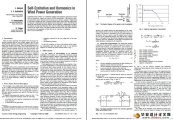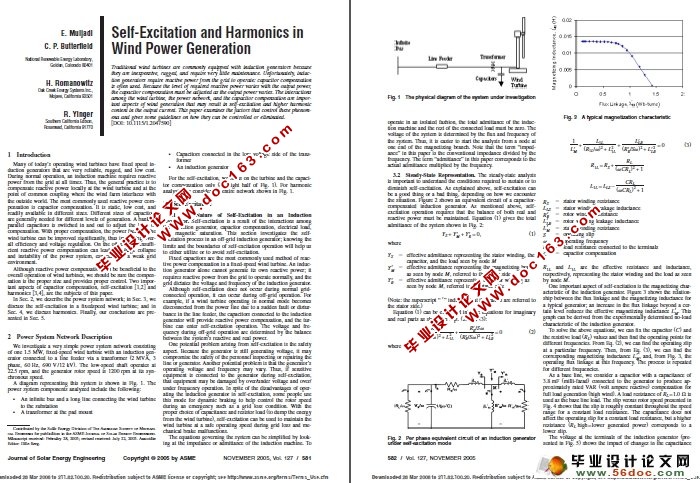风力发电中的自我激励与谐波

风力发电中的自我激励与谐波(中文3900字,英文2800,英文PDF)
1.介绍
传统的风力涡轮机通常安装的是感应发电机,因为它廉价,耐用,而且只需要很少的维护。然而,电感应发电机需要的无功功率通常通过电容器补偿来得到。因为输出功率各不相同,所以电容补偿必须随之调整。风力发电机组的电力网络中,相互的电容补偿作用是导致输出电流中产生自我激励和高次谐波的一个重要原因。这篇文章探讨产生这些现象的原因,并对如何控制或消除这些现象提出一些方法。
现在大部份风力发电机的性能是非常可靠的,并且维修简单,费用低。一台感应发电机在正常工作期间始终需要得到无功功率。使用最普遍的无功功率补偿是电容器补偿,因为它是静态的, 而且成本低。不同型号的电容器可以提供不同的电容补偿。
虽然无功的动力补偿可能对风轮机总的操作有利,但是我们必须确保补偿是恰当的,并且不影响控制。自我激励和谐波是电容器补偿的两个重要部分也是这篇文章的主题。
2.动力系统网络描述
Self-Excitation and Harmonics in Wind Power Generation
E. Muljadi , C. P. Butterfield
National Renewable Energy Laboratory, Golden, Colorado 80401 [资料来源:http://doc163.com]
H. Romanowitz
Oak Creek Energy Systems Inc.,Mojave, California 93501
R. Yinger
Southern California Edison,Rosemead, California 91770
Traditional wind turbines are commonly equipped with induction generators because they are inexpensive, rugged, and require very little maintenance. Unfortunately, induction generators require reactive power from the grid to operate,capacitor compensation is often used. Because the level of required reactive power varies with the output power, the capacitor compensation must be adjusted as the output power varies. The interactions among the wind turbine, the power network, and the capacitor compensation are important aspects of wind generation that may result in self-excitation and higher harmonic content in the output current. This paper examines the factors that control these phenomena and gives some guidelines on how they can be controlled or eliminated.
[资料来源:http://Doc163.com]

[资料来源:http://doc163.com]
